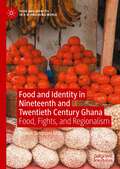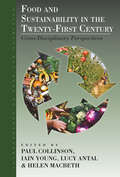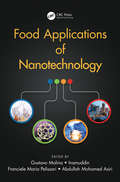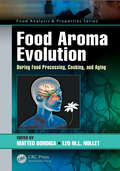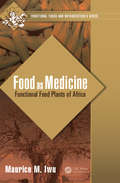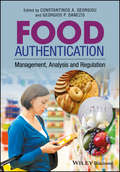- Table View
- List View
Food and Feed from Legumes and Oilseeds
by J. Smartt Emmanuel NwokoloOilseeds and legumes provide a significant proportion of the protein and energy requirements of the world population. This important new book provides comprehensive details of the main oil seed and legume crops focusing particularly on the nutritional aspects of these crops which are, or have the potential to be, more widely exploited in developing countries where are or have the potential to be, more widely exploited in developing countries where protein and energy malnutrition continue to escalate. The predicted rapid rise of populations in many world regions which are increasingly vulnerable to food shortages means that a full knowledge of the nutritional significance of available crops is vital in helping to prevent potential calamities. Food and Feed from Legumes and Oil Seeds has been written by a team of international contributors, each with direct experience of these important crops and their nutritional merits, and the editors are both international experts in the crops covered. This book will become of great value to nutritionists, food and feed scientists and technologists, agricultural scientists and all those involved with overseas developments and food aid organizations.
Food and Free Radicals
by Midori Hiramatsu Toshikazu Yoshikawa Masayasu InoueProceedings of the First Symposium held in Yamagata, Japan, June 16, 1994
Food and Human Responses: A Holistic View
by Kodoth Prabhakaran NairThis book discusses the role of food and the human nutrition-behavior interface. Food makes us what we are, but in addition to providing adequate nutrition, does it influence behavior? This book looks at this critical question from various angles and considers different concepts and approaches to food, nutrition and well-being. To better understand the entire gamut of the food-behavior linkage, the author unravels the workings of the mind - brain link. The book discusses this aspect and the findings add to the existing fund of knowledge in this area. Much of today’s malaise in humans can be traced to the food consumed by individuals. This book provides a comprehensive picture of the current state of human nutrition and how this can be linked to behavior.
Food and Identity in Nineteenth and Twentieth Century Ghana: Food, Fights, and Regionalism (Food and Identity in a Globalising World)
by Brandi Simpson MillerThis book investigates how cooking, eating, and identity are connected to the local micro-climates in each of Ghana’s major eco-culinary zones. The work is based on several years of researching Ghanaian culinary history and cuisine, including field work, archival research, and interdisciplinary investigation. The political economy of Ghana is used as an analytical framework with which to investigate the following questions: How are traditional food production structures in Ghana coping with global capitalist production, distribution, and consumption? How do land, climate, and weather structure or provide the foundation for food consumption and how does that affect the separate traditional and capitalist production sectors? Despite the post WWII food fight that launched Ghana’s bid for independence from the British empire, Ghana’s story demonstrates the centrality of local foods and cooking to its national character. The cultural weight of regional traditional foods, their power to satisfy, and the overall collective social emphasis on the ‘proper’ meal, have persisted in Ghana, irrespective of centuries of trade with Europeans. This book will be of interest to scholars in food studies, comparative studies, and African studies, and is sure to capture the interest of students in new ways.
Food and Industrial Bioproducts and Bioprocessing
by Nurhan Turgut DunfordFood and Industrial Bioproducts and Bioprocessing describes the engineering aspects of bioprocessing, including advanced food processing techniques and bioproduct development. The main focus of the book is on food applications, while numerous industrial applications are highlighted as well. The editors and authors, all experts in various bioprocessing fields, cover the latest developments in the industry and provide perspective on new and potential products and processes. Challenges and opportunities facing the bioproduct manufacturing industry are also discussed. Coverage is far-reaching and includes: current and future biomass sources and bioprocesses; oilseed processing and refining; starch and protein processing; non-thermal food processing; fermentation; extraction techniques; enzymatic conversions; nanotechnology; microencapsulation and emulsion techniques; bioproducts from fungi and algae; biopolymers; and biodegradable/edible packaging. Researchers and product developers in food science, agriculture, engineering, bioprocessing and bioproduct development will find Food and Industrial Bioproducts and Bioprocessing an invaluable resource.
Food and Industrial Bioproducts and Bioprocessing
by Nurhan Turgut DunfordFood and Industrial Bioproducts and Bioprocessing describes the engineering aspects of bioprocessing, including advanced food processing techniques and bioproduct development. The main focus of the book is on food applications, while numerous industrial applications are highlighted as well. The editors and authors, all experts in various bioprocessing fields, cover the latest developments in the industry and provide perspective on new and potential products and processes. Challenges and opportunities facing the bioproduct manufacturing industry are also discussed. Coverage is far-reaching and includes: current and future biomass sources and bioprocesses; oilseed processing and refining; starch and protein processing; non-thermal food processing; fermentation; extraction techniques; enzymatic conversions; nanotechnology; microencapsulation and emulsion techniques; bioproducts from fungi and algae; biopolymers; and biodegradable/edible packaging. Researchers and product developers in food science, agriculture, engineering, bioprocessing and bioproduct development will find Food and Industrial Bioproducts and Bioprocessing an invaluable resource.
Food and Medicine: A Biosemiotic Perspective (Biosemiotics #22)
by Yogi Hale Hendlin Jonathan HopeThis edited volume provides a biosemiotic analysis of the ecological relationship between food and medicine. Drawing on the origins of semiotics in medicine, this collection proposes innovative ways of considering aliments and treatments. Considering the ever-evolving character of our understanding of meaning-making in biology, and considering the keen popular interest in issues relating to food and medicines - fueled by an increasing body of interdisciplinary knowledge - the contributions here provide diverse insights and arguments into the larger ecology of organisms’ engagement with and transformation through taking in matter. Bodies interpret molecules, enzymes, and alkaloids they intentionally and unintentionally come in contact with according to their pre-existing receptors. But their receptors are also changed by the experience. Once the body has identified a particular substance, it responds by initiating semiotic sequences and negotiations that fulfill vital functions for the organism at macro-, meso-, and micro-scales. Human abilities to distill and extract the living world into highly refined foods and medicines, however, have created substances far more potent than their counterparts in our historical evolution. Many of these substances also lack certain accompanying proteins, enzymes, and alkaloids that otherwise aid digestion or protect against side-effects in active extracted chemicals. Human biology has yet to catch up with human inventions such as supernormal foods and medicines that may flood receptors, overwhelming the body’s normal satiation mechanisms. This volume discusses how biosemioticians can come to terms with these networks of meaning, providing a valuable and provocative compendium for semioticians, medical researchers and practitioners, sociologists, cultural theorists, bioethicists and scholars investigating the interdisciplinary questions stemming from food and medicine.
Food and Nutrition Security in the Kingdom of Saudi Arabia, Vol. 1: National Analysis of Agricultural and Food Security
by Adam E. Ahmed Jameel M. Al-Khayri Azharia A. ElbushraFood and nutrition security is a major concern for Saudi Arabia and the surrounding regions due to the range of challenges they face. These challenges include limited agricultural resources, low self-sufficiency in key food staples, climate change, and high levels of food loss and waste. This book aims to evaluate and analyze the current situation and future prospects of food and nutrition security in Saudi Arabia. Additionally, it seeks to analyze and assess the roles and functions of various institutions related to food security, providing a deeper understanding of the complex problems associated with it. Furthermore, this book aligns with Kingdom Vision 2030, which includes a set of strategies and programs focused on agriculture, food, and water security. It also aligns with the institutional identity of King Faisal University's "Food Security and Environmental Sustainability".The book consists of four volumes. Volume 1, entitled "National Analysis of Agriculture and Food Security" aims to assess the current state of food security in Saudi Arabia, covering key aspects such as agriculture and food resources, food systems, crops, livestock, poultry, fisheries, animal health, food loss and waste, transportation and strategic reserve infrastructure, food security institutions, population, agricultural extension, climate change, agricultural mechanization, smart agriculture, and the utilization of solar energy.This book is highly significant for professionals, researchers, policymakers, and entrepreneurs involved in food and nutrition security in Saudi Arabia, the Gulf Cooperation Council, and various national and international organizations. It offers a comprehensive analysis of the obstacles and possibilities in ensuring food and nutrition security, as well as presenting practical approaches to address these issues. Additionally, graduate students studying in fields related to food and nutrition security will benefit from this book.
Food and Nutrition Security in the Kingdom of Saudi Arabia, Vol. 2: Macroeconomic Policy and Its Implication on Food and Nutrition Security
by Adam E. Ahmed Jameel M. Al-Khayri Azharia A. ElbushraFood and nutrition security is a major concern for Saudi Arabia and the surrounding regions due to the range of challenges they face. These challenges include limited agricultural resources, low self-sufficiency in key food staples, climate change, and high levels of food loss and waste. This book aims to evaluate and analyze the current situation and future prospects of food and nutrition security in Saudi Arabia. Additionally, it seeks to analyze and assess the roles and functions of various institutions related to food security, providing a deeper understanding of the complex problems associated with it. Furthermore, this book aligns with Kingdom Vision 2030, which includes a set of strategies and programs focused on agriculture, food, and water security. It also aligns with the institutional identity of King Faisal University's "Food Security and Environmental Sustainability".The book consists of four volumes. Volume 2 is entitled "Macroeconomic Policy Implications on Food and Nutrition Security". It covers various areas, including food price, loss and waste, processing, finance, trade, investment, quality and safety, consumption patterns, climate change, early warning systems, nutrition institutions, oil revenue, and the significance of date palm and Hassawi rice, genetically modified food, and edible insects in ensuring food and nutritional security.This book is highly significant for professionals, researchers, policymakers, and entrepreneurs involved in food and nutrition security in Saudi Arabia, the Gulf Cooperation Council, and various national and international organizations. It offers a comprehensive analysis of the obstacles and possibilities in ensuring food and nutrition security, as well as presenting practical approaches to address these issues. Additionally, graduate students studying in fields related to food and nutrition security will benefit from this book.
Food and Nutritional Supplements: Their Role in Health and Disease
by Nicholas W. Read Judith K. Donnelly Joan K. RansleyConsumer interest in diet and nutritional supplements is increasing dramatically. This book is designed to meet the needs of those professionals who are called upon to advise patients and the general public. It provides a valuable text for those who are researchers or decision-makers in the food and pharmaceutical industries. The text presents a thorough account of this topical subject and enables the reader to appreciate the functions of nutrients in health and common disease states, to understand the current debates over the roles of nutrients and supplements in the diet, and to answer those questions frequently asked by patients and consumers.
Food and Potential Industrial Applications of Bambara Groundnut
by Samson A. Oyeyinka Beatrice I. O. Ade-OmowayeBambara groundnut (Vigna subterranea) is a crop native to the Bambara tribe of Mali and is grown as a subsistence crop in Africa. Recent advances in research, however, have brought the crop to the forefront of the sustainable agriculture movement.The Bambara plant is highly drought tolerant and rich in protein and carbohydrates, including starch. These macromolecules have enormous industrial potentials. For example, the starch in Bambara grain has been found to exhibit higher (double) viscosity than conventional corn starch. Modified Bambara groundnut starch has been used to produce edible bioplastics that could be upgraded industrially to suit the fourth industrial revolution shift.Bambara plants are also a natural source of soluble fiber, which is gluten-, lactose- and cholesterol-free, with potential as a stabiliser, thickener and gelling agent as well as a cryoprotectant in frozen products. The health benefits include lowering of cholesterol levels, levelling of blood glucose and as a detoxing aid. Furthermore, several researchers have explored the grain either alone or as composite with cereal and tubers for the development of value-added products.Food and Potential Industrial Applications of Bambara Groundnut presents in a clear, coherent way the research findings on Bambara grain and its status as a promising food and industrial crop.
Food and Sustainability in the Twenty-First Century: Cross-Disciplinary Perspectives (Anthropology of Food & Nutrition #9)
by Paul Collinson Iain Young Lucy Antal Helen MacbethSustainability is one of the great problems facing food production today. Using cross-disciplinary perspectives from international scholars working in social, cultural and biological anthropology, ecology and environmental biology, this volume brings many new perspectives to the problems we face. Its cross-disciplinary framework of chapters with local, regional and continental perspectives provides a global outlook on sustainability issues. These case studies will appeal to those working in public sector agencies, NGOs, consultancies and other bodies focused on food security, human nutrition and environmental sustainability.
Food and Sustainability in the Twenty-First Century: Cross-Disciplinary Perspectives (Anthropology of Food & Nutrition #9)
by Paul Collinson, Iain Young, Lucy Antal and Helen MacbethSustainability is one of the great problems facing food production today. Using cross-disciplinary perspectives from international scholars working in social, cultural and biological anthropology, ecology and environmental biology, this volume brings many new perspectives to the problems we face. Its cross-disciplinary framework of chapters with local, regional and continental perspectives provides a global outlook on sustainability issues. These case studies will appeal to those working in public sector agencies, NGOs, consultancies and other bodies focused on food security, human nutrition and environmental sustainability.
Food and the Immune System: Molecular Mechanisms and Nutritional Relevance in Health and Disease
by Christopher BeermannNutrition is an important environmental factor for the maturation of the human immune system and essential for maintaining immunological homeostasis. Based on this, a variety of food applications with medical claims are being generated by food manufacturers worldwide in order to expand the market potential of products creating interesting linkages with other market segments, such as cosmetics and pharmaceuticals. However, in addition to the health benefits, active principles of such components often remain unexplored.This book focusses on the specific interactions between food ingredients and the immune system along the entire immune defense response. Starting from the immune barrier, through the innate and adaptive immune response, to active limitation and termination, all major mechanisms of the immune response are addressed and different biochemical, cellular and genetic interactions of components of our diet are discussed. The book presents a wealth of disease patterns for which nutritional factors are relevant and thereby provides indications for potential intervention strategies. In addition, associated food-technological aspects are discussed. Being the first of its kind, this book provides an overview of the variety of functional food components and their influence on immunological responses. Written in an accessible style, it addresses researchers, health professionals and students with different scientific backgrounds.
Food Applications of Nanotechnology
by Gustavo Molina Inamuddin Franciele Maria Pelissari Abdullah Mohamed AsiriNanotechnology has developed remarkably in recent years and, applied in the food industry, has allowed new industrial advances, the improvement of conventional technologies, and the commercialization of products with new features and functionalities. This progress offers the potential to increase productivity for producers, food security for consumers and economic growth for industries. Food Applications of Nanotechnology presents the main advances of nanotechnology for food industry development. The fundamental concepts of the technique are presented, followed by examples of application in several sectors, such as the enhancement of flavor, color and sensory characteristics; the description of the general concepts of nano-supplements, antimicrobial nanoparticles and other active compounds into food; and developments in the field of packaging, among others. In addition, this work updates readers on the industrial development and the main regulatory aspects for the safety and commercialization of nanofoods. Features: Provides a general overview of nanotechnology in the food industry Discusses the current status of the production and use of nanomaterials as food additives Covers the technological developments in the areas of flavor, color and sensory characteristics of food and food additives Reviews nanosupplements and how they provide improvements in nutritional functionality Explains the antibacterial properties of nanoparticles for food applications This book will serve food scientists and technologists, food engineers, chemists and innovators working in food or ingredient research and new product development. Gustavo Molina is associate professor at the UFVJM (Diamantina—Brazil) in Food Engineering and head of the Laboratory of Food Biotechnology and conducts scientific and technical research. His research interests are focused on industrial biotechnology. Dr. Inamuddin is currently working as assistant professor in the chemistry department of Faculty of Science, King Abdulaziz University, Jeddah, Saudi Arabia. He is also a permanent faculty member (assistant professor) at the Department of Applied Chemistry, Aligarh Muslim University, Aligarh, India. He has extensive research experience in multidisciplinary fields of analytical chemistry, materials chemistry, and electrochemistry and, more specifically, renewable energy and environment. Prof. Abdullah M. Asiri is professor of organic photochemistry and has been the head of the chemistry department at King Abdulaziz University since October 2009, as well as the director of the Center of Excellence for Advanced Materials Research (CEAMR) since 2010. His research interest covers color chemistry, synthesis of novel photochromic and thermochromic systems, synthesis of novel coloring matters and dyeing of textiles, materials chemistry, nanochemistry and nanotechnology, polymers, and plastics. Franciele Maria Pelissari graduated in Food Engineering; earned her master’s degree (2009) at the University of Londrina (UEL), Londrina, Brazil; and her PhD (2013) at the University of Campinas (Unicamp), Campinas, Brazil. Since 2013, she has been associate professor at the Institute of Science and Technology program at the Federal University of Jequitinhonha and Mucuri (UFVJM), Diamantina, Brazil, in Food Engineering, and also full professor in the graduate program in Food Science and Technology.
Food Applications of Nanotechnology
by Gustavo Molina Inamuddin Franciele Maria Pelissari Abdullah Mohamed AsiriNanotechnology has developed remarkably in recent years and, applied in the food industry, has allowed new industrial advances, the improvement of conventional technologies, and the commercialization of products with new features and functionalities. This progress offers the potential to increase productivity for producers, food security for consumers and economic growth for industries. Food Applications of Nanotechnology presents the main advances of nanotechnology for food industry development. The fundamental concepts of the technique are presented, followed by examples of application in several sectors, such as the enhancement of flavor, color and sensory characteristics; the description of the general concepts of nano-supplements, antimicrobial nanoparticles and other active compounds into food; and developments in the field of packaging, among others. In addition, this work updates readers on the industrial development and the main regulatory aspects for the safety and commercialization of nanofoods. Features: Provides a general overview of nanotechnology in the food industry Discusses the current status of the production and use of nanomaterials as food additives Covers the technological developments in the areas of flavor, color and sensory characteristics of food and food additives Reviews nanosupplements and how they provide improvements in nutritional functionality Explains the antibacterial properties of nanoparticles for food applications This book will serve food scientists and technologists, food engineers, chemists and innovators working in food or ingredient research and new product development. Gustavo Molina is associate professor at the UFVJM (Diamantina—Brazil) in Food Engineering and head of the Laboratory of Food Biotechnology and conducts scientific and technical research. His research interests are focused on industrial biotechnology. Dr. Inamuddin is currently working as assistant professor in the chemistry department of Faculty of Science, King Abdulaziz University, Jeddah, Saudi Arabia. He is also a permanent faculty member (assistant professor) at the Department of Applied Chemistry, Aligarh Muslim University, Aligarh, India. He has extensive research experience in multidisciplinary fields of analytical chemistry, materials chemistry, and electrochemistry and, more specifically, renewable energy and environment. Prof. Abdullah M. Asiri is professor of organic photochemistry and has been the head of the chemistry department at King Abdulaziz University since October 2009, as well as the director of the Center of Excellence for Advanced Materials Research (CEAMR) since 2010. His research interest covers color chemistry, synthesis of novel photochromic and thermochromic systems, synthesis of novel coloring matters and dyeing of textiles, materials chemistry, nanochemistry and nanotechnology, polymers, and plastics. Franciele Maria Pelissari graduated in Food Engineering; earned her master’s degree (2009) at the University of Londrina (UEL), Londrina, Brazil; and her PhD (2013) at the University of Campinas (Unicamp), Campinas, Brazil. Since 2013, she has been associate professor at the Institute of Science and Technology program at the Federal University of Jequitinhonha and Mucuri (UFVJM), Diamantina, Brazil, in Food Engineering, and also full professor in the graduate program in Food Science and Technology.
Food Aroma Evolution: During Food Processing, Cooking, and Aging (Food Analysis & Properties)
by Matteo Bordiga Leo M. L. NolletOf the five senses, smell is the most direct and food aromas are the key drivers of our flavor experience. They are crucial for the synergy of food and drinks. Up to 80% of what we call taste is actually aroma. Food Aroma Evolution: During Food Processing, Cooking, and Aging focuses on the description of the aroma evolution in several food matrices. Not only cooking, but also processing (such as fermentation) and aging are responsible for food aroma evolution. A comprehensive evaluation of foods requires that analytical techniques keep pace with the available technology. As a result, a major objective in the chemistry of food aroma is concerned with the application and continual development of analytical methods. This particularly important aspect is discussed in depth in a dedicated section of the book. Features Covers aromatic evolution of food as it is affected by treatment Focuses on food processing, cooking, and aging Describes both classic and new analytical techniques Explains how the flavor perception results are influenced by other food constituents The book comprises a good mix of referenced research with practical applications, also reporting case studies of these various applications of novel technologies. This text represents a comprehensive reference book for students, educators, researchers, food processors, and food industry personnel providing an up-to-date insight. The range of techniques and materials covered provides engineers and scientists working in the food industry with a valuable resource for their work. Also available in the Food Analysis & Properties Series: Ambient Mass Spectroscopy Techniques in Food and the Environment, edited by Leo M.L. Nollet and Basil K. Munjanja (ISBN: 9781138505568) Hyperspectral Imaging Analysis and Applications for Food Quality, edited by N.C. Basantia, Leo M.L. Nollet, and Mohammed Kamruzzaman (ISBN: 9781138630796) Fingerprinting Techniques in Food Authentication and Traceability, edited by Khwaja Salahuddin Siddiqi and Leo M.L. Nollet (ISBN: 9781138197671) For a complete list of books in this series, please visit our website at: www.crcpress.com/Food-Analysis--Properties/book-series/CRCFOODANPRO
Food Aroma Evolution: During Food Processing, Cooking, and Aging (Food Analysis & Properties)
by Matteo Bordiga, Leo M.L. NolletOf the five senses, smell is the most direct and food aromas are the key drivers of our flavor experience. They are crucial for the synergy of food and drinks. Up to 80% of what we call taste is actually aroma. Food Aroma Evolution: During Food Processing, Cooking, and Aging focuses on the description of the aroma evolution in several food matrices. Not only cooking, but also processing (such as fermentation) and aging are responsible for food aroma evolution. A comprehensive evaluation of foods requires that analytical techniques keep pace with the available technology. As a result, a major objective in the chemistry of food aroma is concerned with the application and continual development of analytical methods. This particularly important aspect is discussed in depth in a dedicated section of the book. Features Covers aromatic evolution of food as it is affected by treatment Focuses on food processing, cooking, and aging Describes both classic and new analytical techniques Explains how the flavor perception results are influenced by other food constituents The book comprises a good mix of referenced research with practical applications, also reporting case studies of these various applications of novel technologies. This text represents a comprehensive reference book for students, educators, researchers, food processors, and food industry personnel providing an up-to-date insight. The range of techniques and materials covered provides engineers and scientists working in the food industry with a valuable resource for their work. Also available in the Food Analysis & Properties Series: Ambient Mass Spectroscopy Techniques in Food and the Environment, edited by Leo M.L. Nollet and Basil K. Munjanja (ISBN: 9781138505568) Hyperspectral Imaging Analysis and Applications for Food Quality, edited by N.C. Basantia, Leo M.L. Nollet, and Mohammed Kamruzzaman (ISBN: 9781138630796) Fingerprinting Techniques in Food Authentication and Traceability, edited by Khwaja Salahuddin Siddiqi and Leo M.L. Nollet (ISBN: 9781138197671) For a complete list of books in this series, please visit our website at: www.crcpress.com/Food-Analysis--Properties/book-series/CRCFOODANPRO
Food as Medicine: Functional Food Plants of Africa (Functional Foods and Nutraceuticals)
by Maurice M. IwuThis comprehensive book documents African plants used for functional and medicinal foods. It contains more than 60 detailed monographs of African foods, describing foods with various characteristics such as prebiotic, probiotic, satiety, immune modulation, stress-reduction, sports performance, mental acuity, sleep-supporting, metabolic syndrome, antioxidant, and unsaturated fats. Plant description, botanical names and synonyms, plant part used, habitat and distribution, folk use, nutritional content, and chemistry are all fully detailed. The book highlights indigenous African food processing technologies up to the modern era.
Food as Medicine: Functional Food Plants of Africa (Functional Foods and Nutraceuticals)
by Maurice M. IwuThis comprehensive book documents African plants used for functional and medicinal foods. It contains more than 60 detailed monographs of African foods, describing foods with various characteristics such as prebiotic, probiotic, satiety, immune modulation, stress-reduction, sports performance, mental acuity, sleep-supporting, metabolic syndrome, antioxidant, and unsaturated fats. Plant description, botanical names and synonyms, plant part used, habitat and distribution, folk use, nutritional content, and chemistry are all fully detailed. The book highlights indigenous African food processing technologies up to the modern era.
Food Associated Pathogens
by Wilhelm Tham Marie Louise Danielsson-ThamTo stem the tide of foodborne illness, it is important to understand the source of the problem. This volume examines pathogenic bacteria, viruses, protozoan parasites, moulds, and mycotoxins in food. It also discusses food-associated antimicrobial resistance and lessons learned from an actual foodborne outbreak. The book also explores clinical aspe
Food Authentication
by Philip R. Ashurst M.J. DennisThe issue of food authenticity is not new. For centuries unscrupulous farmers and traders have attempted to 'extend', or othewise alter, their products to maximise revenues. In recent years the subject has reached new prominence and there even have been situations where food authenticity has featured as a newspaper headline in various countries. Food legislation covering the definition, and in some cases composition, of various commodities has been in place in developed countries for many years and paradoxically it is the legislative trend away from emphasis on composition and more on accurate and truthfullabeliing that has been one driving force for the authenticity issue. Another, and many would speculate as the more potent, driving force is the move towards fewer and larger supermarket chains in many countries. Such trading companies with their images of quality products, buying power and commercial standing, exercise considerable commercial power which has been claimed as a significant source of financial pressure on food prices and food commodity product quality. For whatever reason, recent food authenticity issues have become news and consumers, the media and enforcement authorities are showing more interest than ever before in the subject.
Food Authentication: Management, Analysis and Regulation
by Constantinos A. Georgiou Georgios P. DanezisThe determination of food authenticity is a vital component of quality control. Its importance has been highlighted in recent years by high-profile cases in the global supply chain such as the European horsemeat scandal and the Chinese melamine scandal which led to six fatalities and the hospitalisation of thousands of infants. As well as being a safety concern, authenticity is also a quality criterion for food and food ingredients. Consumers and retailers demand that the products they purchase and sell are what they purport to be. This book covers the most advanced techniques used for the authentication of a vast number of products around the world. The reader will be informed about the latest pertinent analytical techniques. Chapters focus on the novel techniques & markers that have emerged in recent years. An introductory section presents the concepts of food authentication while the second section examines in detail the analytical techniques for the detection of fraud relating to geographical, botanical, species and processing origin and production methods of food materials and ingredients. Finally, the third section looks at consumer attitudes towards food authenticity, the application of bioinformatics to this field, and the Editor’s conclusions and future outlook. Beyond being a reference to researchers working in food authentication it will serve as an essential source to analytical scientists interested in the field and food scientists to appreciate analytical approaches. This book will be a companion to under- and postgraduate students in their wander in food authentication and aims to be useful to researchers in universities and research institutions.
Food Authentication: Management, Analysis and Regulation
by Contantinos A. Georgiou Georgios P. DanezisThe determination of food authenticity is a vital component of quality control. Its importance has been highlighted in recent years by high-profile cases in the global supply chain such as the European horsemeat scandal and the Chinese melamine scandal which led to six fatalities and the hospitalisation of thousands of infants. As well as being a safety concern, authenticity is also a quality criterion for food and food ingredients. Consumers and retailers demand that the products they purchase and sell are what they purport to be. This book covers the most advanced techniques used for the authentication of a vast number of products around the world. The reader will be informed about the latest pertinent analytical techniques. Chapters focus on the novel techniques & markers that have emerged in recent years. An introductory section presents the concepts of food authentication while the second section examines in detail the analytical techniques for the detection of fraud relating to geographical, botanical, species and processing origin and production methods of food materials and ingredients. Finally, the third section looks at consumer attitudes towards food authenticity, the application of bioinformatics to this field, and the Editor’s conclusions and future outlook. Beyond being a reference to researchers working in food authentication it will serve as an essential source to analytical scientists interested in the field and food scientists to appreciate analytical approaches. This book will be a companion to under- and postgraduate students in their wander in food authentication and aims to be useful to researchers in universities and research institutions.
Food Bioactives: Functionality and Applications in Human Health
by Sankar Chandra Deka Dibyakanta Seth Nishant Rachayya Swami HulleThis valuable volume addresses the growing consumer demand for novel functional food products and for high-value, nutritionally rich products by focusing on the sources and applications of bioactives from food. The chapters in the book describe functional properties and discuss applications of the selected food ingredients obtained from various sources, including culinary banana, phalsa, pseudocereals, roselle calyces, asparagus, and more.Several chapters address the resurgence of interest in pseudocereals due to their excellent nutritional and biological values, gluten-free composition, and the presence of some health-promoting compounds. The book also looks at utilizing industrial byproducts for making functional and nutraceutical ingredients. The chapters on prebiotics and probiotics highlight different functional properties, and a chapter on food allergens discusses advancements in detection and management in the food manufacturing industries.



